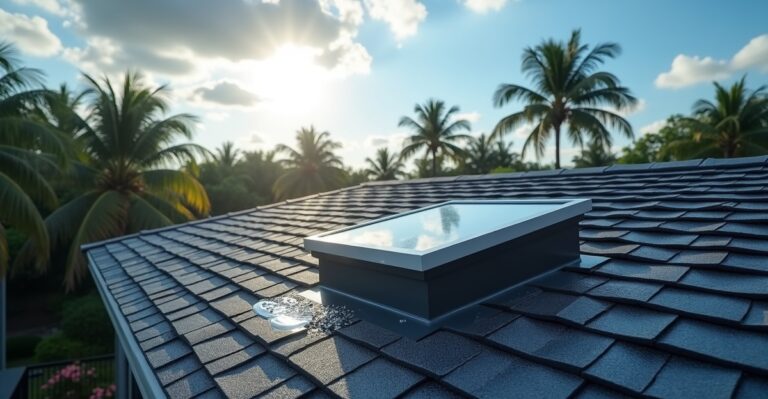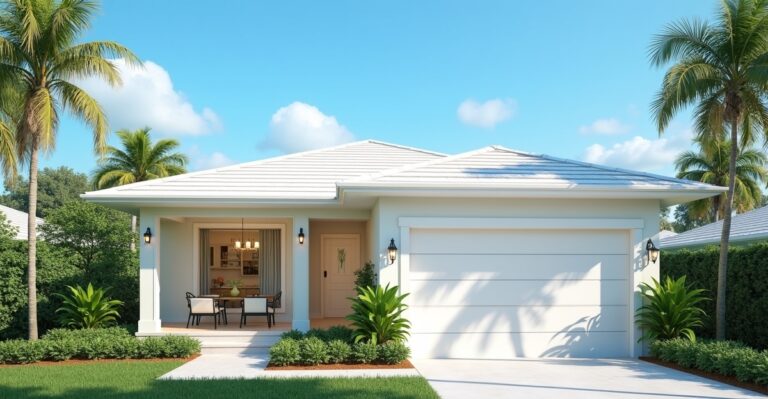What Should Be Included in a Roofing Estimate?
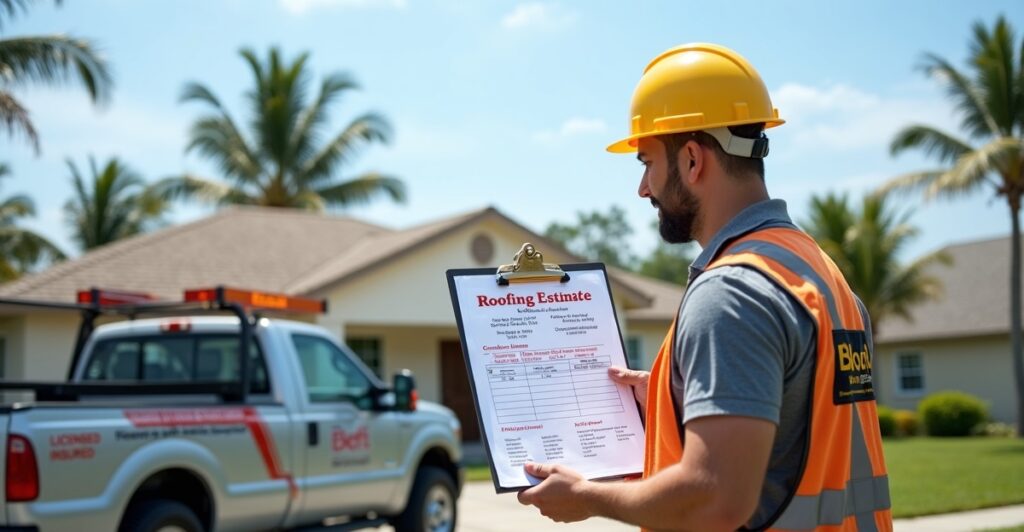
A complete roofing estimate Florida homeowners can rely on includes far more than a final cost. It needs to outline key details like licensing, insurance, materials, labor, project timeline, warranty coverage, and local code compliance. By understanding each section, we can compare proposals with clarity and select a contractor who meets Florida’s strict structural and weather resistance standards.
Key Takeaways
- Every estimate must include the contractor’s valid Florida license number, current proof of liability and workers’ compensation insurance, full business name, and dependable local contact details. This protects us and confirms the contractor operates legally in the state.
- Clear cost breakdowns should separate charges for materials, labor, cleanup, permitting, and any potential extras. A detailed list helps avoid surprises and shows which parts of the bid might be negotiable or estimated.
- The written scope of work should describe exactly what the contractor will complete, how long the project will take, and how the crew will handle cleanup. Given Florida’s frequent rain and storms, the timeline should also account for possible weather delays.
- The estimate must fully describe how the contractor will manage permitting, meet state and local building codes, and install features like wind mitigation attachments. These elements affect both legal compliance and long-term insurance discounts.
- Warranty coverage should list how long materials and labor are guaranteed, what is excluded, and whether the warranties move with the home if it’s sold. This offers peace of mind and helps protect long-term investment.
What to Look for First: Licensed, Local, and Insured
The very first thing a proper roofing estimate in Florida should include is clear, complete company information. This isn’t just paperwork—it’s proof that you’re working with a legitimate roofing contractor committed to doing the job right. Here’s what that foundational info should include:
- Full business name
- Florida contractor license number
- Proof of insurance (general liability and workers’ compensation)
- A physical address located in Florida
- Reliable contact information (phone and email)
We recommend reviewing this information before anything else. If any of these items are missing or vague, especially the license number or a real local address, that’s a red flag.
Why a Florida Roofing License Matters
Not all roofing licenses are created equal. Roofing in Florida comes with specific challenges—like humidity, salt air, and hurricane-force winds. That’s why it’s important to hire only licensed roofing contractors in Florida. These professionals are trained to work under the state’s strict building codes and climate demands.
A Florida license isn’t a blanket certification. It shows the contractor is qualified to handle roofing systems suited to our local weather, materials, and insurance requirements. Before signing anything, we recommend verifying the license through the Florida Department of Business and Professional Regulation. It’s quick and could save you from major headaches.
Insurance Coverage to Protect Everyone
No matter how experienced a crew is, roofing involves risk. A slip on the ladder or dropped shingle can lead to costly consequences. That’s why every roofing estimate in Florida should come with active proof of two types of coverage:
- General liability insurance: Covers property damage, including your home or landscaping, from any mishaps during roofing work.
- Workers’ compensation insurance: Protects you from being held financially responsible if a worker gets injured while on your roof.
If a contractor can’t readily show documentation for both, it’s best to keep looking. Hiring an uninsured roofer puts your home and finances at risk.
Watch for signs that raise concerns. A contractor using only a P.O. box or unwilling to meet in person is often not operating with full transparency. Same goes for any estimate missing a license number—no matter how friendly or helpful they seem.
Choosing a contractor who checks all these boxes is the first step in making sure your roof work gets done legally, safely, and up to Florida standards. As you’re reviewing quotes and comparing professionals, you can also explore what’s typically included in a full roofing estimate in Florida to make sure you’re getting a thorough assessment.
If storm damage is involved, it’s also smart to verify whether your insurance may help cover the cost. That kind of upfront clarity makes it easier to plan your budget and your next steps.
Need help from licensed roofing contractors in Florida who live and work in your community? Our team takes pride in being fully licensed, insured, and local—ready to handle your job safely and professionally. If you’re starting with a damaged or aging roof, check out our full roof replacement service to learn how we make the process smooth from start to finish.
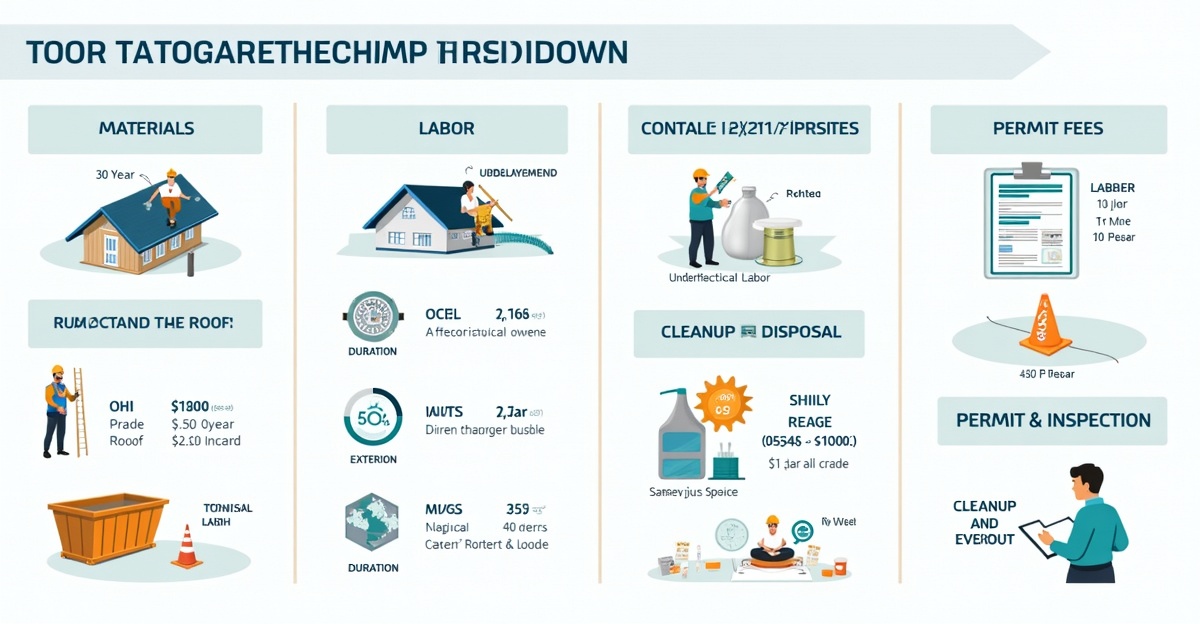
Breaking Down the Numbers: Labor, Materials, and Total Costs
A clear roofing estimate builds trust right from the start. We always recommend reviewing estimates side by side, and the only way to compare fairly is by seeing all the details clearly laid out. A strong estimate should spell out costs in three main categories—materials, labor, and additional items—to avoid surprises and set shared expectations.
What to Look For in a Detailed Estimate
Here are the key components every Florida roof repair cost breakdown should include:
- Materials: Each estimate should list the types and brands of roofing materials being used—such as architectural shingles, underlayment, flashing, and sealants. Good estimates go further, noting things like shingle grade (e.g., 30-year or 50-year lifespan), how much of each material is needed, and what warranties are included from the manufacturer.
- Labor: A trustworthy contractor will summarize labor costs based on crew size and expected duration of the work. We also note if subcontractors are involved and explain any additional charges for weekend or night work, which may apply to certain commercial roofing jobs.
- Contingency Expenses: Sometimes issues arise once the roof is opened up. A solid estimate accounts for possible extras—like replacing rotten decking, installing an emergency tarp, or making unexpected fascia or soffit repairs. These are added as “contingency line items,” so there are no surprises down the road.
- Cleanup and Disposal: Debris removal, dumpster rental, and site cleanup should be part of the quote. If it’s not mentioned, make sure to ask—cleanliness and safety matter just as much as the quality of shingles overhead.
- Permit Fees and Inspections: Roofing projects in Florida often require permits and city or county inspections. These should be clearly noted in your estimate, with either a specified cost or a note stating they’re included in the total.
If you’re reviewing a residential roofing estimate example, expect it to be a bit simpler than a commercial quote. Commercial proposals may also include traffic control, staging zones, or crane rental. Either way, the goal is to lay everything out so we can walk through it together with full transparency.
Understanding pricing is also easier with the right context. If you haven’t already, browse through our article on how much roof repair typically costs in Florida to get a sense of typical costs for different repairs and roof types.
If the estimate calls for a complete roof overhaul, we’ll help you consider your options. Learn more about when a repair will do or when a replacement makes sense in this helpful guide on repairing versus replacing your roof.
When you’re ready, our team can deliver a detailed, honest quote for any project—big or small. Explore our roof repair services or contact us if you’d like help reviewing an estimate you already have in hand. We’ll go through it side-by-side—no pressure, just friendly advice.
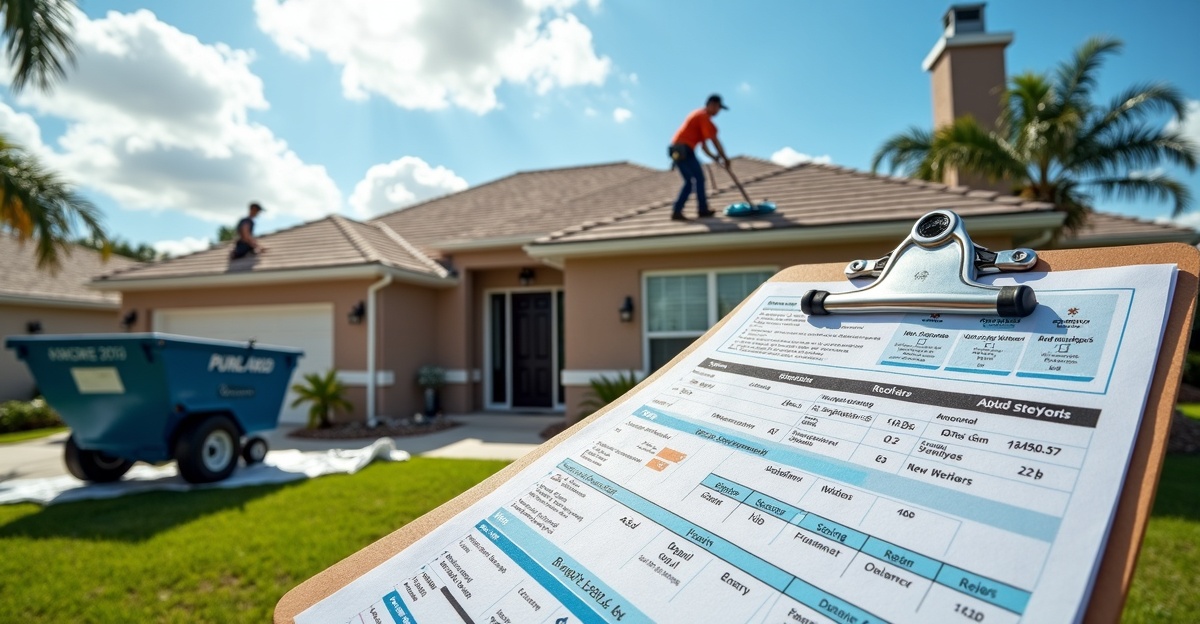
Detailed Work Plan: Scope, Timeline, and Cleanup
A complete roofing contractor proposal should lay out all the essentials—from what’s being done to how long it’ll take and how the site’s left after the work wraps up. This keeps expectations clear and avoids surprises once the job starts. Whether we’re handling a small leak or full replacement, we always begin with defining the project scope in writing.
Key Elements to Look For in the Estimate
Here’s what we include in every solid roofing estimate, so both sides know exactly what’s covered:
- Scope of Work: This spells out if we’re repairing a specific section, stripping old roofing off the entire house, or installing new components like skylights or roof ventilation. We detail materials used, such as shingle type, underlayment, flashing, and fasteners, to eliminate guesswork. If features like fascia and soffit replacements or upgrades to gutters are discussed, we include those line-by-line.
- Timeline and Weather Planning: We include projected start and completion dates that factor in Florida’s weather patterns. Sudden tropical storms or hurricane threats can shift timelines, so the estimate should clearly explain how we’ll handle delays and get back on track safely once conditions clear up.
- Cleanup and Disposal: A responsible estimate explains how the workspace will be managed during and after construction. We use dumpsters to gather old materials, clean the yard with magnetic tools to catch stray nails, and make sure landscape beds are protected from falling debris. Property protection isn’t an afterthought—it’s part of the job.
- Residential vs. Commercial Focus: For homes, our emphasis is on sealing out water, preventing mold, and matching aesthetic features like color and profile. For commercial flat roofs or low-slope applications, we look at long-term goals such as insulation, traffic coatings, or drainage upgrades. These are issues that affect roof lifespan, comfort, and energy use.
- Add-On Items: If upgrades like a skylight install make sense during the project, we’ll break that out separately. From fresh vents to solar-ready prep, add-ons should get their own pricing and completion notes.
We’ve seen far too many estimates that gloss over cleanup or treat the weather as an afterthought. But in Florida, factoring in storms is just part of doing the job right. You can explore how timing plays a role in seasonal planning in our guide on when to replace a roof in Florida.
Including each step in writing protects both sides and makes the process smoother. If a hurricane hits mid-project or surprise rot is found during tear-off, a clear scope tells us what’s covered under the current agreement and what might need separate discussion. That’s especially important during storm damage repair, where insurance claims may rely on date-stamped estimate details.
Homeowners often ask whether a roof can be fixed instead of starting over. Our estimate process helps answer that exactly, showing which areas must be addressed and making it easier to compare repair vs. replacement options. For more info, see our post about repairing instead of replacing a roof.
Working with a team that understands permitting, rain readiness, and post-job care gives lasting peace of mind. Whether you need a small fix or a full roof replacement, the right estimate should leave no gray areas. We’re proud to put everything in writing so you know we’ll show up, stay on schedule, and leave your home cleaner than we found it.
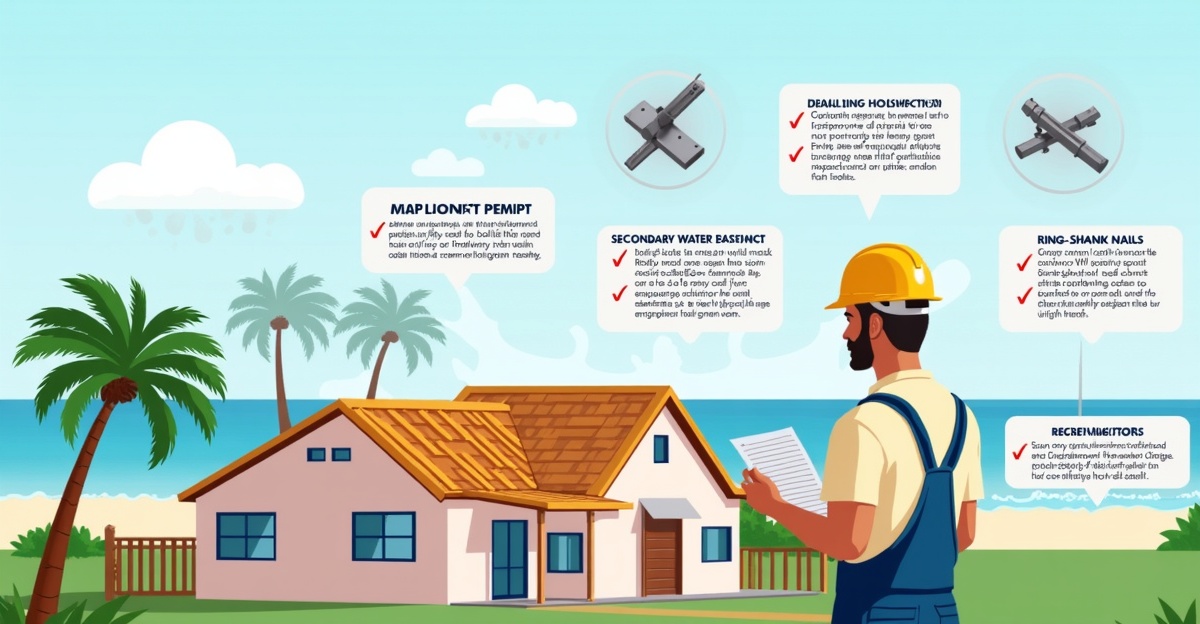
Permits, Compliance, and Florida Code Requirements
Florida’s roofing rules aren’t just red tape—they’re in place to protect homes from hurricane-force winds, salt air, and subtropical weather. That’s why any reliable roofing estimate should clearly outline responsibilities tied to local compliance and code standards.
Inspection and permitting needs vary by municipality. In Florida, most roofing jobs need building permits and final inspections from the county or city. A proper roofing estimate should state upfront who’s handling that process. In nearly all cases, the licensed contractor is responsible for pulling permits and scheduling inspections. If that’s missing from the quote, it’s a red flag. The cost of permits and inspection facilitation should be included in the pricing or itemized clearly.
What to Look For in the Estimate
Here are key code and compliance items that should appear in any honest and complete roofing estimate checklist in Florida:
- Permitting details: A section explaining who will obtain the right permits and arrange final inspections. Ask if the contractor is familiar with your specific county or city office.
- Florida Building Code compliance: Confirmation that the proposed roof system adheres to current Florida Building Codes. If you’re located in a High-Velocity Hurricane Zone (HVHZ)—like South Florida—this includes uplift resistance and fastener spacing specific to hurricane standards.
- Wind mitigation features: Some roofing systems include enhancements like secondary water barriers or ring-shank nails that improve storm resilience. These should be called out in the estimate if included. They might even save money on insurance.
- Insurance-related documentation: For homes near the coast, insurance carriers often require specific reports showing the roof meets code standards. The estimate should clarify whether the contractor will provide documentation for wind mitigation credits or Uniform Mitigation Verification Inspection Forms after completion.
- Awareness of changing codes: Florida updates its building codes every three years. If there are known upcoming changes that could affect shingle types, fastening methods, or ventilation systems, a well-informed contractor should mention how their plan takes this into account. For example, Central and Northeast Florida may soon adopt stricter underlayment standards for aging shingles as part of the 8th Edition Florida Building Code draft.
If you’re unsure whether a repair will meet new code updates or if replacement is a smarter long-term move, check out this guide on roof repair vs. replacement considerations.
Some code-related features might not be strictly required but are worth including for better durability and protection. Things like enhanced eave protection or hurricane strap reinforcements can be smart add-ons, especially near the coast or in areas with older framing practices.
Beyond code, don’t forget to confirm that licensed professionals are involved in all stages. This includes pulling permits under a valid license number and being on-site during inspections.
We bring experience across multiple Florida counties and take responsibility for all required permits as part of our roof replacement services. That means fewer delays, no guesswork, and full compliance for inspections and insurance reviews.
Every solid roofing quote should do more than list out materials and labor. It should show detailed awareness of Florida’s code environment—because that’s key to securing both your property and your investment.
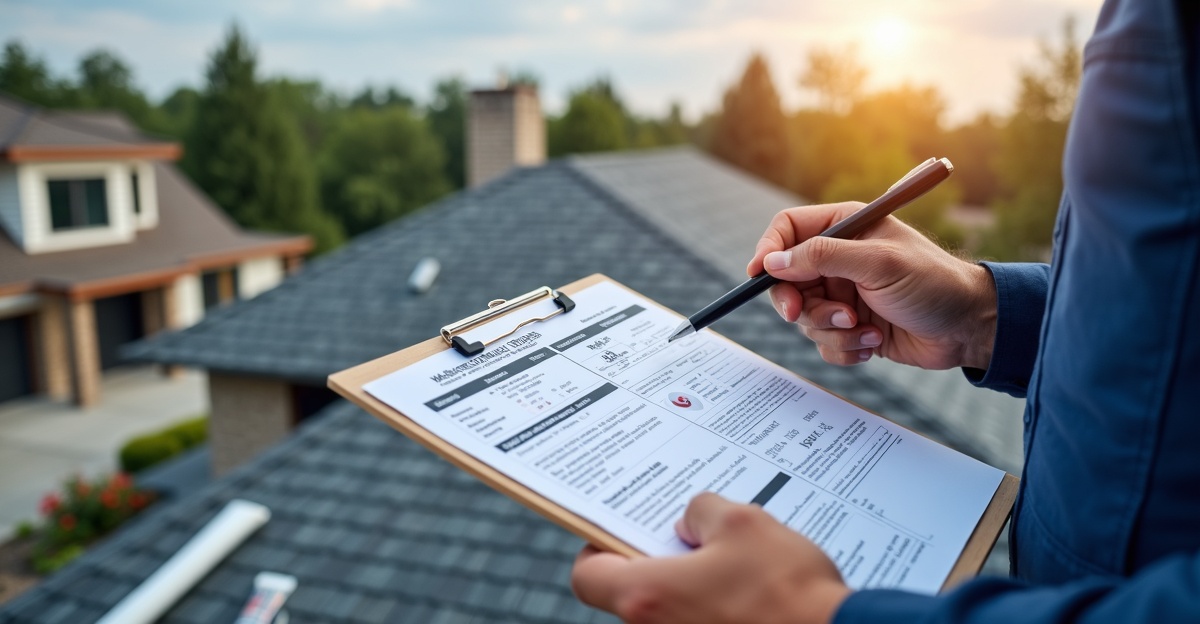
Warranty Coverage and Long-Term Protection
A solid roofing estimate doesn’t just list materials and labor—it outlines peace of mind. One of the most important parts of any bid should be a clear explanation of warranty coverage. This ensures we know what the contractor stands behind and what protection we’re getting from the material manufacturers.
What to Look for in Roofing Warranties
When reviewing what’s included in a roofing bid, we always check for detailed warranty information. It should break down both the material and workmanship coverage. Here’s how each one matters:
- Material Warranty – Offered by the manufacturer, this covers defects in roofing products like shingles, sealants, or underlayment. Look for terms like “lifetime limited warranty” or “30-year shingle warranty,” but don’t stop there. It’s key to understand if the coverage is prorated, how claims are handled, and whether certain maintenance is required.
- Workmanship Warranty – Provided by the roofing contractor, this backs the quality of the installation. Good contractors typically offer a warranty ranging from 5 to 15 years. This covers mistakes made during installation but often excludes damage from future storms, falling branches, or neglected maintenance. That’s where clear language matters.
We always recommend checking if the estimate outlines exclusions clearly. For example, warranties won’t cover storm damage unless specified—and in that case, insurance usually plays a role. We break that down further in our guide on storm damage and insurance.
For those managing commercial properties, this takes on even more importance. Many flat or low-slope systems use coating methods that require regular upkeep. In these cases, some warranties are renewable—meaning if we follow a scheduled maintenance plan, the warranty extends. This can be cost-effective over the long haul and provides predictable protection.
Another detail we always look for is whether the warranty is transferable. If we might sell the property during the warranty period, a transferable warranty can add real value. It shows the next owner that the roof was installed by professionals and is still under protection. Most quality roofing manufacturers and experienced contractors include this as an option, but it isn’t guaranteed.
We also want to be sure that whoever installs the roof is authorized by the material manufacturer. Some high-tier warranty options—like extended or “platinum” warranties—require certified installation. That’s something we confirm upfront to avoid surprises later.
If we’re weighing repair versus replacement, warranty terms often tip the scales. Repairs might fix immediate issues, but they won’t usually reset a material warranty or come with long-term labor coverage. For a detailed look at comparing both options, visit roof repair vs. replacement.
The warranty language in a roofing estimate shouldn’t feel vague or overly technical. We expect it to explain:
- The start date and full length of coverage
- What events or damage types are covered
- What’s excluded (especially common wear, weather events, or homeowner neglect)
- Who to contact for claims or service
- Whether and how the warranty can transfer with ownership
Some bids even bundle extended warranties into the total price. Others offer them as options. A contractor with confidence in their work won’t hesitate to spell this out clearly. Our team at Pyramid has always believed honest, well-documented estimates lead to better decisions.
To see more about what’s typically outlined in professional quotes, including pricing and scope, you can explore typical roofing costs in Florida.
A trustworthy roofing estimate will also provide reassurance beyond warranties. It reflects how experienced and reliable the team is. We back our installations with dependable coverage, and we offer complete roof replacement services that include straightforward warranty terms from start to finish. We want every client to feel informed and protected—not just now, but years down the road.

Payment Terms, Optional Add-Ons, and Red Flags to Avoid
A trustworthy roofing estimate lays out payment terms in black and white. That means clearly stated deposit amounts, billing milestones, and accepted forms of payment. Many reputable contractors divide billing into progress payments, with a deposit up front, a mid-project installment, and the final balance after completion. Estimates should also flag any financing options, late payment penalties, or seasonal discounts. If those aren’t listed, it’s worth asking.
Optional Services Worth Considering
Not all roofing jobs end with shingles and nails. A well-prepared contractor should give us the option to include upgrades or bonus services. These extra touches can improve our home’s comfort and efficiency long term. Common optional add-ons include:
- Skylight installation for natural light and better ventilation
- Roof ventilation upgrades to improve airflow and extend roof life
- Extended maintenance plans that cover routine inspections and minor repairs
- Drone roof inspections for hard-to-reach areas or steep pitches
Many homeowners choose to include skylights or ventilation improvements during installation. If we’re planning ahead for peace of mind and performance, these upgrades are worth discussing. We recommend browsing through options like our roof ventilation services to see what aligns with our needs and budget.
Watch for Common Red Flags
Not every contractor offering an estimate is reliable. Unfortunately, storm-chaser crews can flood our neighborhoods after hurricanes, offering vague bids with short timelines. Here are signs we’re dealing with someone less than reputable:
- Estimates that lack itemized costs or use unclear terms like “miscellaneous fees”
- Verbal promises without written confirmation
- Demands for full payment upfront
- Surcharges added after we’ve signed
- Out-of-town license plates, no local references, and poor communication
Scheduling flexibility is another issue, especially after storms. A good estimate should note availability for weekday, weekend, or emergency work. For local hurricane response, make sure the provider offers licensed storm damage repair services—not just quick fixes.
Also, if our property is commercial, ensure the contractor provides a detailed commercial roofing estimate checklist covering workspace safety, staging plans, and weekend work preferences. These details often make or break a timeline when business is at stake.
If we’re uncertain about the numbers or scope, we can compare multiple estimates using a roofing estimate checklist Florida. A downloadable version helps track what’s missing at a glance and avoid costly misunderstandings.
We also suggest double-checking whether the costs align with averages in our region. If something seems too steep or suspiciously low, this article on roof repair costs in Florida gives a helpful baseline range.
Getting clarity up front saves stress later. Clear estimates and open communication build lasting confidence in the decision—and the roof.

